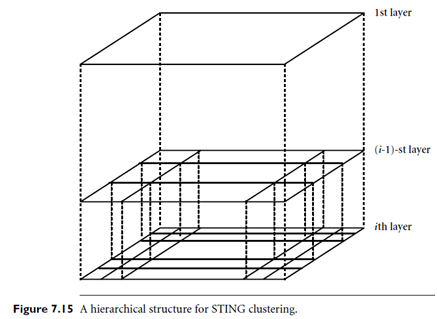SKEDSOFT
Introduction: STING is a grid-based multiresolution clustering technique in which the spatial area is divided into rectangular cells. There are usually several levels of such rectangular cells corresponding to different levels of resolution, and these cells form a hierarchical structure: each cell at a high level is partitioned to form a number of cells at the next lower level. Statistical information regarding the attributes in each grid cell (such as the mean, maximum, and minimum values) is pre computed and stored. These statistical parameters are useful for query processing, as described below.
Figure 7.15 shows a hierarchical structure for STING clustering. Statistical parameters of higher-level cells can easily be computed from the parameters of the lower-level cells. These parameters include the following: the attribute-independent parameter, count; the attribute-dependent parameters, mean, stdev (standard deviation), min (minimum), max (maximum); and the type of distribution that the attribute value in the cell follows, such as normal, uniform, exponential, or none (if the distribution is unknown).When the data are loaded into the database, the parameters count, mean, stdev, min, and max of the bottom-level cells are calculated directly from the data. The value of distribution may either be assigned by the user if the distribution type is known beforehand or obtained by hypothesis tests such as the χ2 test. The type of distribution of a higher-level cell can be computed based on the majority of distribution types of its corresponding lower-level cells in conjunction with a threshold filtering process. If the distributions of the lower level cells disagree with each other and fail the threshold test, the distribution type of the high-level cell is set to none.
 “How is this statistical information useful for query answering?” The statistical parameters can be used in a top-down, grid-based method as follows. First, a layer within the hierarchical structure is determined from which the query-answering process is to start. This layer typically contains a small number of cells. For each cell in the current layer, we compute the confidence interval (or estimated range of probability) reflecting the cell’s relevancy to the given query. The irrelevant cells are removed from further consideration. Processing of the next lower level examines only the remaining relevant cells. This process is repeated until the bottom layer is reached. At this time, if the query specification is met, the regions of relevant cells that satisfy the query are returned. Otherwise, the data that fall into the relevant cells are retrieved and further processed until they meet the requirements of the query.
“How is this statistical information useful for query answering?” The statistical parameters can be used in a top-down, grid-based method as follows. First, a layer within the hierarchical structure is determined from which the query-answering process is to start. This layer typically contains a small number of cells. For each cell in the current layer, we compute the confidence interval (or estimated range of probability) reflecting the cell’s relevancy to the given query. The irrelevant cells are removed from further consideration. Processing of the next lower level examines only the remaining relevant cells. This process is repeated until the bottom layer is reached. At this time, if the query specification is met, the regions of relevant cells that satisfy the query are returned. Otherwise, the data that fall into the relevant cells are retrieved and further processed until they meet the requirements of the query.
“What advantages does STING offer over other clustering methods?” STING offers several advantages: (1) the grid-based computation is query-independent, because the statistical information stored in each cell represents the summary information of the data in the grid cell, independent of the query; (2) the grid structure facilitates parallel processing and incremental updating; and (3) the method’s efficiency is a major advantage: STING goes through the database once to compute the statistical parameters of the cells, and hence the time complexity of generating clusters is O(n), where n is the total number of objects. After generating the hierarchical structure, the query processing time is O(g), where g is the total number of grid cells at the lowest level, which is usually much smaller than n.
Because STING uses a multiresolution approach to cluster analysis, the quality of STING clustering depends on the granularity of the lowest level of the grid structure. If the granularity is very fine, the cost of processing will increase substantially; however, if the bottom level of the grid structure is too coarse, it may reduce the quality of cluster analysis. Moreover, STING does not consider the spatial relationship between the children and their neighboring cells for construction of a parent cell. As a result, the shapes of the resulting clusters are isothetic; that is, all of the cluster boundaries are either horizontal or vertical, and no diagonal boundary is detected. This may lower the quality and accuracy of the clusters despite the fast processing time of the technique.